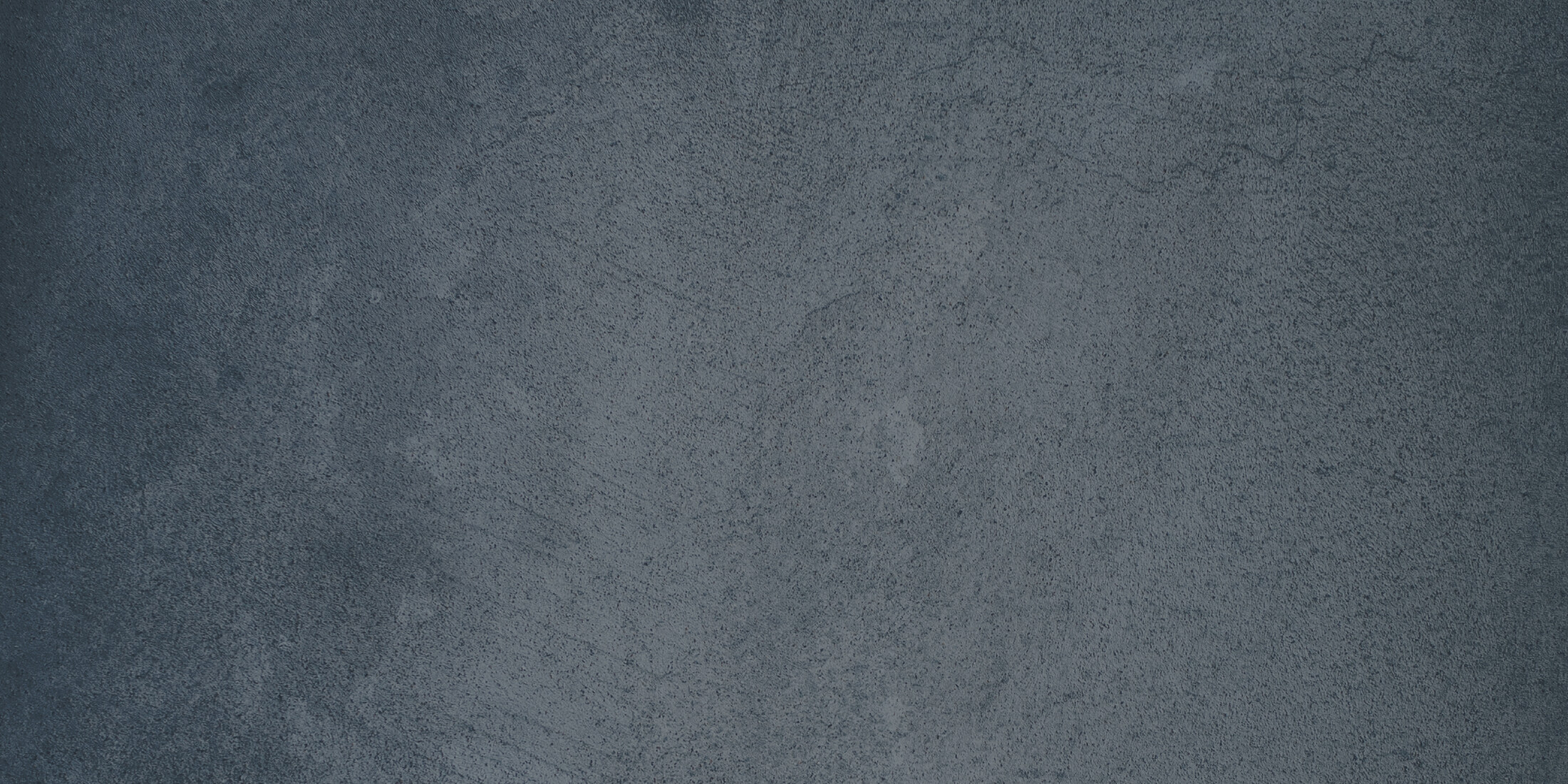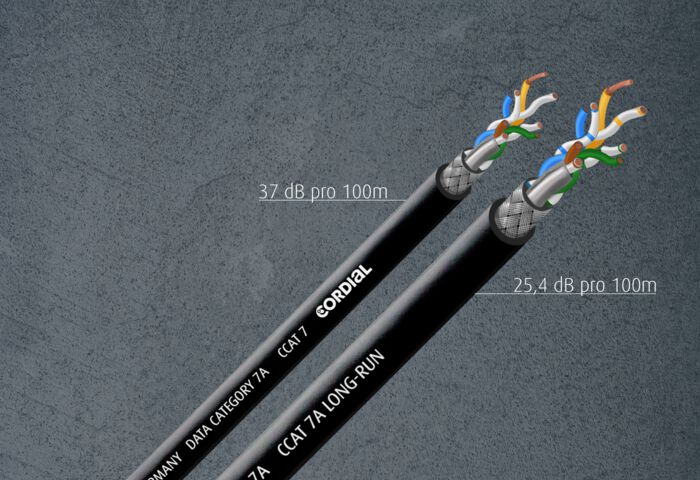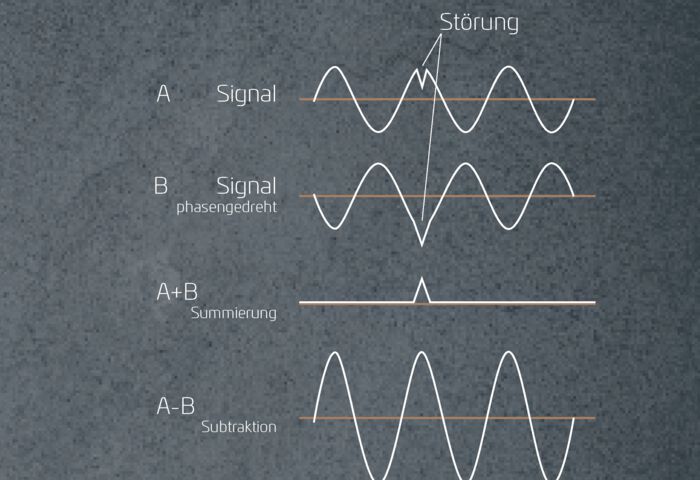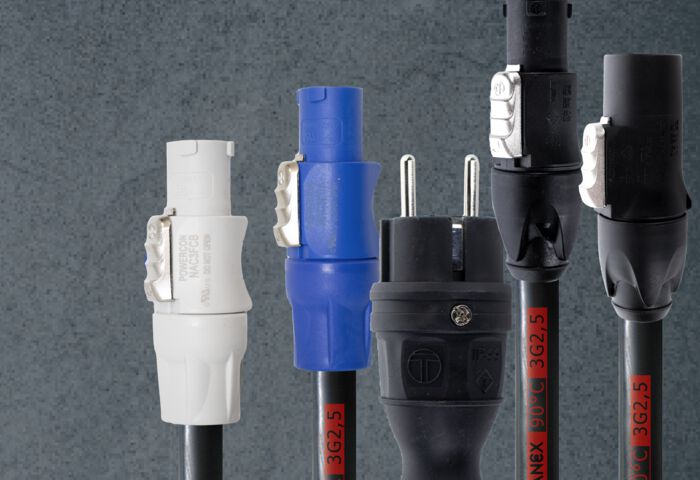In data cables, the intensity of the inducted signal decreases continuously over the cable length. The logarithmic proportion of transmitter- to receiver level is defined as attenuation.
The measure is decibel (dB).
It is common that the attenuation, which is especially important for multicore cables and which grows linearly with the cable length, is stated for a length of 100 m.
In the audio range, losses in a copper conductor contribute to the attenuation.

Attenuation
AWG
AWG ("American Wire Gauge") is a wire diameter coding to precisely define the diameter ratio of cables. AWG is determined by certain mathematical formulas and is listed in AWG tables. Simplified, AWG is the cable cross-section (in mm²) x conductor resistance.
AWG value - influence on signal quality
The AWG value is used to define the diameter and cross-section of electrical conductors (both single wires and stranded wires). The AWG value of a cable has a direct influence on the data quality - since the smaller the AWG value, the thicker the wire.
Braided Shield
In braided shielding, metal strands (often copper) are braided around the inside of the cable. The wires are bare or tinned (tin plating for corrosion protection).
Braided Shield pt. 2
Balanced and unbalanced cables
When it comes to choosing the right cable, one will soon come upon the terms "balanced" (symmetrical) and "unbalanced" (technical term asymmetrical).
Balanced Assembling
A cable should have a balanced design, that means with twisted pairs, to guarantee an undisturbed transmission over a long distance. The audio signal will be transmitted in-phase opposite to both inner cores. The interferences, which are not kept out by the screen, show equiphase behaviour and cancel each other out on transformer- and electrically- balanced inputs. This allows – with transformer-balanced inputs- an ungrounded connection between electronic equipment without the dreaded ground loop.

Capacitance
What is capacitance and to what extent does it affect my music? The longer the cable, the greater the capacitance, and the more treble amounts are filtered out of the signal.
Capacitance PT. 2
The capacity of a conductor circuit, stated in Farad (F), depends on the distance between the conductors and on the dielectric coefficient of the insulating material: the smaller the distance between the conductors, the higher the capacity. The usual small distance between the wires usually generates relatively high values of capacitance (130pF), that can be affected by the appropriate selection of the insulation material (for example PE), so that capacities below 70 pF can be achieved. As these capacities result in a low-pass filter reaction of the cable, attenuating highs with large transmission paths, sensitive applications, like transformer balanced and high resistance tube microphones or tube preamplifiers and power amps can be affected. Therefore, this effect has to be considered carefully.
It is worthwhile listening exactly!
CAT categories
Ethernet cables are currently divided into different classes or categories (CATegories) according to their bandwidth and data speed.
CAT cable
Since 2002, the use of Category 5 twisted pair cables (Cat 5e - specification of suitability for Gigabit Ethernet) has been standard for Gigabit networks and in the course of consistent further technological development Cat 6 and Cat 7 was added.
The terms are common – but in what way do these cables actually differ?
Characteristic Impedance
The characteristic impedance in cable technology is defined as input impedance of a homogeneous conductor with endless length.
The measure is Ohm.
The frequency-dependent progression of the characteristic impedance enables statements about incoming signal distortion at imperfections. Frequently the impedance is named as characteristic impedance. The characteristic impedance is constructively forced by the sizes of the inner conductors, the dielectric and the screening. It does not depend on the cable length. The characteristic impedance is insignificant in low-frequency audio applications, but important with high-frequency uses like digital transmission and converting (for example the AES/EBU standard: 110 ohms). There you have to make sure that the characteristic impedance allowances are at +/- 20% of a maximum according to standard, otherwise reflections could distort the signal and especially the signal edge (jitter), thus virtually preventing authentic interpretation. “State-of-the-art” cables offer impedance tolerances of +/- 10% at 3 and 6 MHz.
Compatibility of Ethernet cables
To be able to make use of the full range of functions, you should always use a cable whose standards correspond to the periphery. For Ethernet applications in Europe, the predominant current standard is the RJ-45 connector type. Once the connector compatibility is given, downward compatibility is no longer an issue. Conversely, the matter becomes much more complex.
Conductor Resistance
This is the DC resistance of the conductor, which depends on the resistance of the conductor material.
It is stated in ohms.
During the transmission of AC with expanding frequency the current does not evenly spread over the conductor area. At high frequencies the current transmission is finally effected only on the conductor surface (skin effect). This can be important for digital data communication; it is insignificant in the range of low-frequency audio uses! The conductor resistance for microphone- and multicore cables should be below 100 ohms/km and for loudspeaker cables below 10 ohms/km.
Core Insulation
The insulation provides the galvanic separation of the cores with different potentials against each other as well as against other conductive components (e.g. shielding) and ground. Commonly used insulation materials are PVC and PE, whereas PE allows lower and therefore better capacitive values. This is especially audible at longer runs, where the cable starts to cut treble. In such applications PE ought to be used. When processing the cables with soldering irons or soldering baths the temperature stability of the insulation is important. You can often find thermic instabilities caused by shrinking core insulation.
Conductor type - influence on signal transmission
The type of conductor(s) has a significant influence on signal transmission within a cable. We differentiate between "stranded = multiple strands" and "solid = one strand".
Crosstalk
Crosstalk characterises the unwanted passing of signal energy in close-by circuit lines. Causes are capacitive and inductive couplings as well as marginal leak loss. Stated is the logarithmic proportion of signal power in the sending pair of cores to the incoming power in the defective pair of cores. The measure is decibel (dB), the numerical value should be as high as possible. By twisting close-by pairs with different lengths of twists and by screening activities crosstalk can be minimized.
Current
Most of the equipment used on stage needs a lot of power, so selecting the appropriate and applicable cable is crucial.
DI Boxes
DI boxes are commonly used to connect electrical instruments with unbalanced outputs (e.g. keyboards) to balanced inputs. Especially for longer signal paths in live environments, balanced signal routing can be used to reduce interfering external influences such as humming noises.
DMX cables
DMX (Digital Multiplex) is a standard protocol for controlling digital signal transmission between a transmitter with DMX output and lighting equipment with DMX input. To transmit these control signals, appropriate DMX cables are used.
Electrical conductivity
It’s all about a simple physical factor: resistance. Aluminum has the highest resistance (0.028 µΩ*m), so its conductivity is the worst of the three. Silver conducts best, because it has the lowest resistance (0.016 µΩ*m) of the three, but copper doesn’t trail far behind with a resistance of 0.018 µΩ*m.
Foil Shield
In most cases, a foil shield consists of a plastic foil - coated with aluminum on the outside and bare on the inside - which usually covers the inner conductors 100 percent.
Foil Shield PT. 2
Ground loops
The humming from the amplifier or the mixer is, so to speak, current you hear. On the one hand, you have lots of different power sources, on the other, numerous different devices, which are all earthed and connected to sockets (different circuits/potentials). And, in between, instrument cables, practically becoming a kind of bridging between 2 earthed sockets - and you will hear that because the so-called equalizing current flows through the shielding (ground) of the cable. This then will be perceived as a low-frequency interference signal. Experts call this phenomenon a ground loop.
Hybrid cables
We all know that power and data cables should not be laid out directly next to each other - the electrical field of the power cable will then disturb the signal. Why then have we developed a hybrid cable combining a DMX and a power cable? Won’t the electrical field disturb the signal?
Inductance
The inductance of a conductor circuit, stated in Henry (H), depends basically on the distance between both conductors: the larger the distance, the larger the inductance!
As the cores in audio cables are in close proximity, the inductance is very small and therefore insignificant.
Inner Core
The main and most important element is the inner core. Here you have to distinguish between massive cores and strands. Massive cores use one massive wire as a conductor, whereas the stranded version of the conductor consists of several thin strands and achieves a higher flexibility.
In general: the thinner the strands are the more flexible the cable will be. Flexibility is most important in mobile use of microphone-, instrument-, loudspeaker- and multicore cables. Besides that, you have to pay special attention to the conductor cross section in case of long cable runs.
The common rule is: The bigger the conductor cross section, the lower the conductor resistance and the better the transmission. This is of utmost importance in the microphone cable field and so cross sections of 0.20 mm² or even better 0.22 mm² are common. For long distances we even recommend 0.50 mm². These values have to be evaluated as the case arises and the usage has to be decided on accordingly. When using loudspeaker cables, special attention has to be given to the conductor cross section due to modern power amplifiers which generate power of 2,000 Watts at 8 ohms respectively 4,000 Watts at 4 ohms in the bass range. Here, maximum values of 180 volts at 40 amperes are reached, which have to be transmitted by the loudspeaker cables. Conductor cross sections which are too small lead to considerable loss of power and in the end possibly to cable failures. Where speakers are concerned, cables with two, four and eight poles in the range of 1.5 mm² to 8 mm² are available according to the system specifications.
Instrument- and speaker cables
Loudspeaker cables and instrument cables differ in their construction, as they are designed for different currents. For example, the diameter of instrument cables is too small for high current loads, such as those that flow between the (pre)amplifier and the speakers during the transmission of amplified low-frequency instrument signals.
Insulating Resistance
The insulating resistance indicates the electrical loss of the conductor.
You can easily imagine these losses as leakage current which flows to the ground via the conductor insulation. The resistance the insulation current has to overcome on the way through the insulator, is the insulating resistance. It should be as high as possible.
The length of a conductor affects the conductor and insulation resistance in different ways: when the conductor resistance grows with the increasing length of a core, the insulating resistance abates at the same ratio.
Isolator - influence on signal transmission
The efficient and safe transmission of signals (as well as current or voltage) is ensured by the insulator within a cable. In the absence of insulation, the cable's wire(s) would be exposed to external influences and cause interference, resulting in signal loss.
Jacket
MIDI
MIDI is the basis for the exchange of information, in this case between computers, electronic instruments and other hardware.
Notch Rupture Strength
For designing durable, stageworthy cables, the jacket’s notch resistance is crucial. It ensures that a notch (e.g. caused by a sharp edge) does not extend any further.
Overall shield
The overall shield provides the best possible protection against electromagnetic interference, especially for twisted pair cables used in data cables, and thus ensures the safest possible transmission of digital signals.
powerCON cables
Resistance
Silent Connectors
A silentPLUG mutes the instrument cable at the exact moment it is plugged in or unplugged from the instrument. This prevents annoying crackling noises.
Shielding
In practice property changes due to wear and tear, e.g. bending of the cable, play a decisive role. Foil and spiral wound screens of lower quality often dislocate in a way that the cores are completely open to distortion. The screening is lessened then. On the other hand, in many applications a high flexibility has to be achieved. In these cases mostly a spiral wound screen is used. Braided screens, due to their better mechanical and tensile strength, are used as overall screens for multicore cables.
The screen of multicores is often tinned which makes further processing considerably easier. Furthermore, we distinguish between separately screened pairs (single screen) and overall screened (overall screen) cables.
So, generally true for delicate applications:
double screening is safer than single screening.
Thanks to the additional jacketing of the cores of microphone cables with conductive plastic, their microphony behaviour can almost be completely reduced. Therefore noise due to bending and moving of the cable can be eliminated.
Spiral Shield
In the spiral shield, single copper braids are wound in parallel around the inside of the cable. High-quality cables with spiral shielding have a high copper quality of the braids within the shield.
Shielding Variants
There are various shields that can protect audio cable conductors against disturbing effects caused by electrical fields.
Shielding - influence on signal transmission
There are unshielded cables ("UTP cable: Unshielded Twisted Pair") and shielded cables (both "FTP cable: Foiled Twisted Pair" and "STP cable: Shielded Twisted Pair").
Signal merging through y-adapters
Can Y-cables be used to merge two audio signals into one?
Skin Effect
The electrons located in the middle of the conductor are exposed to a stronger magnetic field than the electrons further out. Resistance is created (see last week). This practically reduces the cross-section of the conductor and the current flows quasi only at the outer surface of the conductor, i.e. quasi on the skin. Hence the name, skin effect.
Spiral Shield PT. 2
In a spiral wound screen, the single wires are wound in one direction e.g. without crossings, around the cores. The coverage is 90% to 95% thus achieving higher values than with the braided screen. The flexibility is very good. Both types provide a high screening effect against electro magnetic distortion in the low and high frequency ranges.

Textile cable / fabric cable
For a special feel and look, cables can be wrapped with an additional fabric jacket, which on the one hand is soft in the hand and on the other hand enables the special vintage look. Cordial (in contrast to some other manufacturers) uses only its own high-quality bulk cable, which is also used for other Cordial cables, and wraps it with tear-resistant and slowly woven yarn that is both robust and flexible.
Twisting
As regards multicore constructions, the twisting of the single components plays a decisive role, because of the eventuality of a restraining, which can influence mechanical as well as electrical properties considerably .
The cross-talk behaviour can be minimized by the length of the twist (that‘s the length up to the 360 degree rotation of the components). Ribbons or foils of synthetics, respectively fleece, connect a cable lay and avoid that the jacket material will get into the hollow space during the extrusion. That could enormously complicate the stripping or even make it impossible. It also allows the switching of the single elements, thus also improving the flexibility of the cable.
Twisted Pair Cables
If the wires inside the cable are twisted in pairs (or several pairs of wires are twisted together), they are called twisted pair cables. Due to twisting, the electromagnetic fields from outside as well as the interference radiation inside act in constantly changing directions and thus cancel each other out to a large extent.
Unbalanced Assembling
Word Clock
In order that two or more digital audio devices can smoothly work together in a network, a master device must set the so-called word clock rate and all other devices (the "slaves") must follow this clock rate.






































